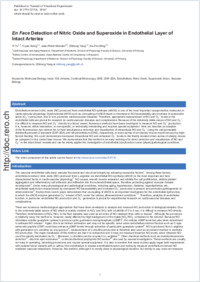"En Face" detection of nitric oxide and superoxide in endothelial layer of intact arteries
- Yu, Yi Cardiovascular and Aging Research, Department of Medicine, Division of Physiology, University of Fribourg, Switzerland
- Xiong, Yuyan Cardiovascular and Aging Research, Department of Medicine, Division of Physiology, University of Fribourg, Switzerland
- Montani, Jean-Pierre System Physiology, Department of Medicine, Division of Physiology, Faculty of Science, University of Fribourg, Switzerland
- Yang, Zhihong Cardiovascular and Aging Research, Department of Medicine, Division of Physiology, University of Fribourg, Switzerland
- Ming, Xiu-Fen Cardiovascular and Aging Research, Department of Medicine, Division of Physiology, University of Fribourg, Switzerland
-
25.02.2016
Published in:
- Journal of Visualized Experiments. - 2016, no. 108, p. e53718
English
Endothelium-derived nitric oxide (NO) produced from endothelial NO-synthase (eNOS) is one of the most important vasoprotective molecules in cardiovascular physiology. Dysfunctional eNOS such as uncoupling of eNOS leads to decrease in NO bioavailability and increase in superoxide anion (O₂.−) production, and in turn promotes cardiovascular diseases. Therefore, appropriate measurement of NO and O₂.− levels in the endothelial cells are pivotal for research on cardiovascular diseases and complications. Because of the extremely labile nature of NO and O₂.−, it is difficult to measure NO and O₂.− directly in a blood vessel. Numerous methods have been developed to measure NO and O₂.− production. It is, however, either insensitive, or non-specific, or technically demanding and requires special equipment. Here we describe an adaption of the fluorescence dye method for en face simultaneous detection and visualization of intracellular NO and O₂.− using the cell permeable diaminofluorescein-2 diacetate (DAF-2DA) and dihydroethidium (DHE), respectively, in intact aortas of an obesity mouse model induced by high-fat-diet feeding. We could demonstrate decreased intracellular NO and enhanced O₂.− levels in the freshly isolated intact aortas of obesity mouse as compared to the control lean mouse. We demonstrate that this method is an easy technique for direct detection and visualization of NO and O₂.− in the intact blood vessels and can be widely applied for investigation of endothelial (dys)function under (physio)pathological conditions.
- Faculty
- Faculté des sciences et de médecine
- Department
- Département de Médecine
- Language
-
- English
- Classification
- Biological sciences
- License
- License undefined
- Identifiers
-
- RERO DOC 259568
- DOI 10.3791/53718
- Persistent URL
- https://folia.unifr.ch/unifr/documents/304867
Statistics
Document views: 73
File downloads:
- zhi_efd.pdf: 144
